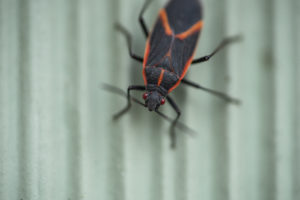The white-footed mouse is a rodent native to North America and is found widely throughout. They measure half a foot in length including their tail and weigh less than one ounce. They have small, black eyes and thin ears. As their name implies, they have white feet and white fur on their bellies, with the rest of their fur reddish-brown in color. They have an excellent sense of sight and hearing and a strong sense of smell that helps them locate food. Cooler temperatures will bring them inside for food and shelter and can lead to food contamination. They can also carry Hantavirus.
Can a White Footed Mouse Spread Hantavirus & Transmit Lyme Disease?
Hantavirus, as the name, applies, to the pathogen that causes the rare and potentially deadly disease known as hantavirus cardiopulmonary syndrome (HPS). It’s transmitted via rodent feces, urine, and saliva. The most common way it’s passed to humans is through inhalation when nesting areas are disturbed and the virus becomes airborne. Avoid touching your nose or mouth after coming into contact with contaminated items. Common places that these mice are found are in vacated homes and crawlspaces. When searching your home for possible infestations, special care needs to be taken to avoid being exposed. Early symptoms of HPS include muscle aches and pains, fatigue and fever. You may also experience chills, dizziness, nausea, headaches and abdominal pain. More severe symptoms, after four to ten days, can include difficulty breathing as the lungs can be filled with fluid, coughing and shortness of breath. There is no known cure, vaccine or treatment, making early detection of symptoms key. The hantavirus kills approximately 30 % to 40% of those that become infected. White-footed mice also help transmit Lyme disease when an infected tick passes the bacteria on to them.
Signs of a Rodent Infestation
White-footed mice can be a nuisance when they feed on seeds and search for nesting areas. They will cause damage when they gnaw at siding, insulation, woodwork, packaged food, and furniture to name a few! White-footed mice can chew on electrical wires that can lead to a fire. In your garden, they will ruin the growth of new crops as they dig them up for food. You might have rodents in your home if you hear scampering and squeaking in the walls or basement, droppings in kitchen cabinets, stored food areas and around your sink. Larger amounts of droppings mean large infestations.
White Footed Mouse Prevention
Exclusion is the best way to avoid an infestation of white-footed mice. Look around the outside of the home and look for any holes or gaps mice might use to get in, and seal them off. Wire mesh or concrete should be used as they will chew through just about anything else. Place mouse traps along runways or anywhere you suspect activity. Mice are smart, so you should use different kinds of traps and continue using the traps until you’re no longer catching them.
Rodent Control
The last thing you want is mice running around your home. Removing large infestations can be challenging and professionals will be able to make a positive identification and use the best methods to eliminate the problem. Contact Rentokil to get a handle on any issues you might be having with white-footed mice or other pests.

 Boxelder bugs are insects that are black with orange or red lines on the thorax and sides. They have flat wings and are ½ an inch long as adults. Outdoors, they make their homes in boxelder, maple, and ash trees. They aren’t pests in the summer as they go unnoticed, but are a problem in the fall as they search for a place to spend the winter. They are generally inactive in the winter but if the day is sunny and warm, they can become mobile in the walls and attic. An infestation may not occur all at once at the same time, as they will be in different parts of the home and the warmth will not reach them all equally. Any boxelder bug you see inside your home in the winter and spring made its way inside the previous fall.
Boxelder bugs are insects that are black with orange or red lines on the thorax and sides. They have flat wings and are ½ an inch long as adults. Outdoors, they make their homes in boxelder, maple, and ash trees. They aren’t pests in the summer as they go unnoticed, but are a problem in the fall as they search for a place to spend the winter. They are generally inactive in the winter but if the day is sunny and warm, they can become mobile in the walls and attic. An infestation may not occur all at once at the same time, as they will be in different parts of the home and the warmth will not reach them all equally. Any boxelder bug you see inside your home in the winter and spring made its way inside the previous fall.